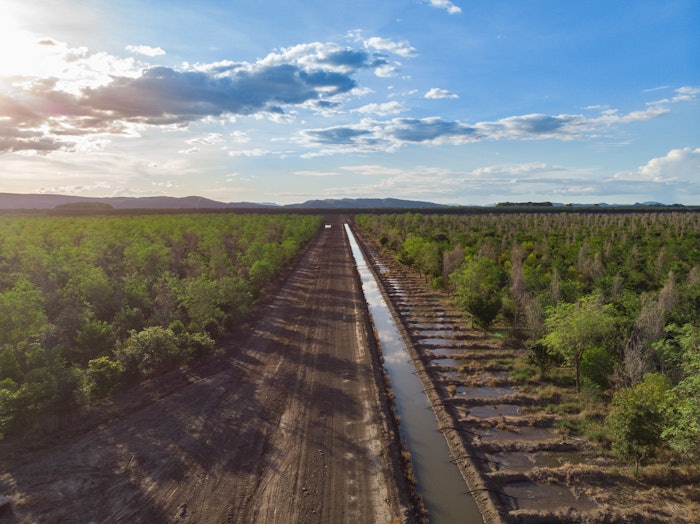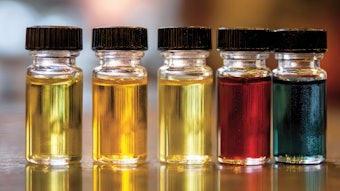
The sandalwood oil market size is projected to reach $175 million by 2028, growing at a CAGR of 8.9% from 2021 to 2028. The evolution of the sandalwood market, more specifically the Indian Sandalwood market, has seen a shift as far as versatility, usage and sourcing. Perfumer & Flavorist+ (P&F+) connects with Dominique Sergi, global account sales manager at Santanol to shed light on the ingredient and how it is transforming within the fragrance and cosmetics industry.
P&F+: Generally, how is Indian Sandalwood sourced?
Dominique Sergi [DS]: Indian sandalwood trees are indigenous primarily to India. High demand and unscrupulous forestry management gradually depleted local resources leading to deforestation in their native environments and fostering a large dubious market. With illegal deforestation and inadequate replanting, the Indian tree was listed as vulnerable to extinction in the wild in the early 2000s.
At the same period, a sustainable approach has been proposed by pioneer companies in Australia to encourage the establishment of sustainable plantations. Santanol promptly seized this opportunity.
For centuries the wood from Santalum spicatum, the Australian endemic botanical tree, was extracted to yield Australian Sandalwood essential oil.
Since the 1990s, Santalum album, the East Indian tree botanical species has been largely planted in plantations in the northern part of Australia, covering large areas where land and water were largely available. Initially, the lands were semi-desert, and the plantations have enhanced biodiversity thanks to the presence of many insects, birds, and animals that are now living in the cultivated areas.
The Australian sustainable production of East Indian Sandalwood essential oil is now recognized as a top and preferred quality by the industry.
It is a long-term investment and engagement as it takes at least 15 years for the Santalum album tree to mature and develop heartwood which yields the precious oil.
There are also many other routines to follow before the oil in its final form is obtained such as:
● Grading of the wood and carefully monitored documentation to ensure robust traceability is maintained throughout the processing
● Three-to-six-month month drying process before the harvested wood is chipped
● Several days to run the distillation
● Many distillation samples to be analyzed and selected to create customized blends
P&F+: Can you share any sustainability innovations that have been developed in recent years?
DS: Everything needs balance, so we are committed to protecting and supporting the wildlife and biodiversity of the region as well as the surrounding indigenous community.
Water management is also a key factor we consider daily. Irrigation systems in our plantations are by natural gravity and flood irrigation, so there is no need for power or diesel-driven pumps.
Sustainable innovation can have an impact on three steps of the value chain:
Agro-Forestry
- Preserving biodiversity: The mix of trees around Santalum album is of importance and the selection represents a real in-house savoir-faire. The Santalum album tree is surrounded by several different host plants during its growth phases creating a diverse ecosystem. By avoiding a monoculture in the plantation areas we have created an ecosystem that attracts and conserves an abundance of wildlife, including wallabies, reptiles and many species of birds and insects.
- End-to-end control: We started collecting the seeds of our most “elite” trees and have created a seed orchard. With this, we are now able to solely plant the healthiest and most diverse seeds from the orchard, giving us control over the supply and improving the oil quality and yield of our sandalwood trees for years. The R&D Centre is continuously developing new methods to ensure the most efficient usage of our resources to create the highest quality trees. In our own plantations in Western Australia, harvesting and planting are rotated annually to ensure a reliable, uninterrupted and consistent supply for the foreseeable future.
- Preserving soil and water: We have developed different techniques using moisture probes in the soil and tree sap flow meters to ensure the water is used in the most efficient way.
Nitrogen is a key nutrient for plant growth that is conventionally added in the form of fertilizer. As said above, a unique requirement of a sandalwood tree is the need for host trees to sustain it. Therefore, host selection has focused on utilizing leguminous species, which have the ability to extract nitrogen from the air and make it available through their root system. This way the sandalwood trees can receive nitrogen naturally.
We choose to use natural approaches to support the healthy growth of our trees such as pruning, natural soil biology, and resilience to diseases through symbiotic relationships with microorganisms. One of our latest approaches is bringing in a herd of goats that are working daily to perform natural weed control. The naturally added organic fertilizer they provide to the soil is a plus and further improves the land.
Wood Preparation & Upcycling
The way we use specific rich parts of the wood (heartwood), stands as a technological and sustainable way to innovate. The spent charge from the distillation is the by-product that is sold into various markets with close to zero waste from the production process.
Distillation: Improving the distillation process in terms of green energy optimization is another sustainable axis to continuously improve our Indian Sandalwood essential oil production.
All power supplied to the factory where the distillations are performed is derived from green renewable energy: the plantation operations use hydroelectric power from the Ord River.
Water from parts of the distillation process is recycled to ensure efficient water usage.
P&F+: What are some of the nuances of Indian Sandalwood’s olfactive profile? How does it differ from others?
DS: Compared to all other sandalwoods, what makes East Indian Sandalwood also called Mysore Sandalwood (in recognition of its birthplace in India) the most unique is its highest concentration of alpha and beta santalols (70-90%).
Alpha santalol is said to be responsible for the therapeutic nature of the oil, and beta santalol, gives Indian sandalwood its incomparable olfactive profile. The so-called “King of Woods,” offers a soft-creamy wooden signature profile as well as a “liquid gold” appearance.
Native Australian Sandalwood differs slightly with a more herbaceous profile with green facets.
P&F+: How has it evolved over time and how is it used today in the fragrance and cosmetic industry?
DS: Known for thousands of years, sandalwood was first used by the Egyptians to embalm their mummies. It is also used in India during funeral ceremonies to allow the soul to rise.
Indian Sandalwood oil is a rare and expensive ingredient which, above its use in the most iconic successes through the history of perfumery, especially in fine fragrance, has a religious dimension as well as medicinal and cosmetic properties.
Santalum album oil has been utilized for many centuries in both Ayurvedic and traditional Chinese medicine. Skin beneficial effects have been now studied with scientific in-vivo techniques. Our Santalum album (Chemotype produced on our own plantations) shows promising properties in Skin and Hair treatments.
The latest Santanol proprietary clinical study demonstrated the in-vivo effectiveness of Sandalwood oil in preventing and hedging excessive hair loss. Promising results for hair care treatments have been announced recently at the prestigious London IFSCC conference last September.
It has been shown that the use of sandalwood oil at 0.5% on the scalp for 3 months by volunteers suffering from androgenic alopecia results in a statistically significant increase in the percentage of anagen hair (+6.3%) and a statistically significant decrease in the percentage of telogen hair (-6.4%). This study demonstrated the in vivo effectiveness of Sandalwood oil in preventing excessive hair loss.
Santalum album oil is today emerging as an interesting active source of many phytochemicals with other personal care promising applications.










